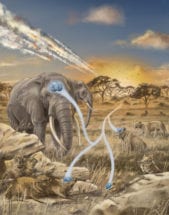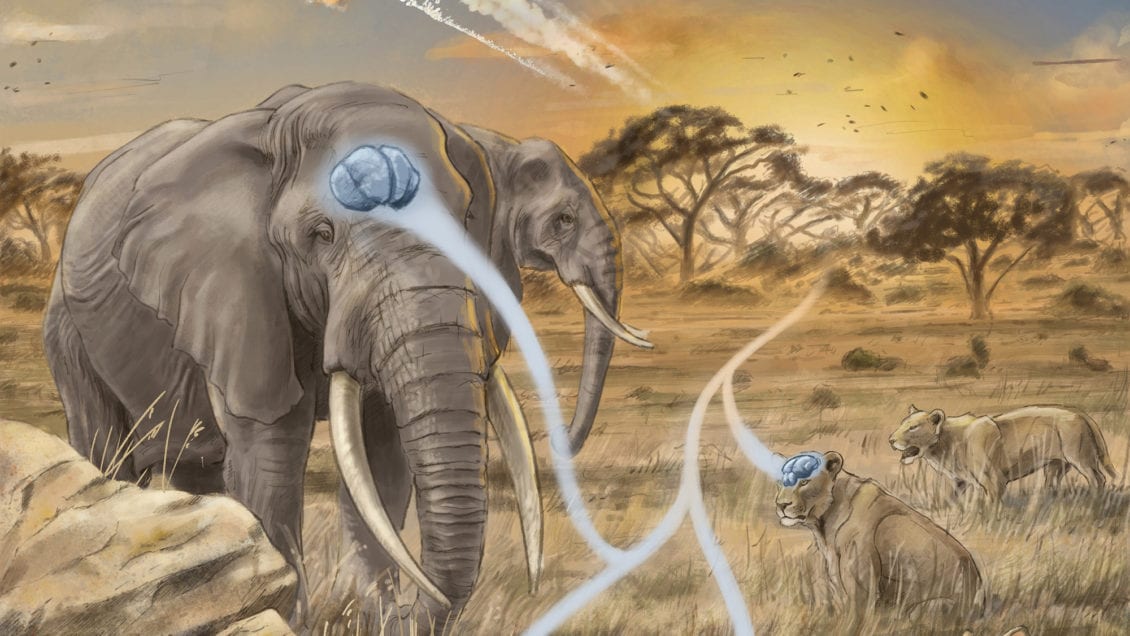When an international team of researchers began their research, the goal was more than ambitious: They sought to discover how mammalian brain size has changed throughout the past 150 million years.
The team, including Adam Smith, Clemson University paleontologist and curator of the Bob Campbell Geology Museum, now has published the largest study of its kind that shows how mammalian brain size has changed throughout the past 150 million years, in some cases adapting to geological and climatic changes.
Paleontologists study fossils to learn more about the history of the Earth. Smith and his colleagues used data they collected from more than 1,000 extinct and modern-day species to look at total brain volume. For this study, Smith helped develop methods to analyze data on living and extinct mammalian brain volumes. These data were compared with body sizes to determine the size of mammals’ brains in relation to their body sizes.
Some animals, such as humans, have large brains for body size while other animals, such as the dinosaur T-rex, had very tiny brains given the enormity of their body size.
“We were able to discover when in Earth’s history brains became larger in a variety of mammalian groups,” Smith said. “We were able to discern the overall pattern and timing of mammalian brain evolution. This helped develop a timeline for brain size evolution and these methods hold great promise to be applied to other groups of animals such as cephalopods (mollusks), often considered the ‘smartest’ of the invertebrates, or perhaps to sub-groups such as hominids (humans and close relatives), or even dinosaurs.”
Five mass extinction events have taken place in the past 500 million years. The mass extinction event that occurred at the end of the Cretaceous period, the Cretaceous-Paleogene extinction, occurred 66 million years ago and is the most recent mass extinction. It was during this time an estimated at least 76% of all species, including the non-avian dinosaurs, were annihilated after a 6-mile wide asteroid slammed in to the planet.

The new study shows that, after the mass extinction event at the end of the Cretaceous period, there were dramatic shifts in brain-body scaling in mammals such as rodents, bats and carnivores as these animals moved into the empty niches left by extinct dinosaurs. Roughly 30 million years later, a significantly cooling climate in the Late Paleogene period led to more profound changes, with seals, bears, whales and primates all undergoing evolutionary shifts in their brain and body size. During this transition, the Earth underwent major climatic changes. Global temperatures plummeted and what had once been a warm, greenhouse-type climate became colder and the first Antarctic ice sheets appeared.
“A big surprise was that much of the variation in relative brain size of mammals that live today can be explained by changes that their ancestral lineages underwent following these cataclysmic events,” said lead author Jeroen Smaers, an evolutionary biologist at Stony Brook University. “This includes evolution of the biggest mammalian brains, such as dolphins, elephants and great apes, which all evolved their extreme proportions after the climate change event 23-33 million years ago.”
Intelligence not related to brain size
The findings, published in the journal Science Advances, further show that brain size relative to body size—long considered an indicator of animal intelligence—has not followed a predictable trajectory over evolutionary time. For example, famous “big-brained” humans, dolphins and elephants attained their proportions in different ways. Elephants increased in body size, but surprisingly, even more in brain size. Dolphins, on the other hand, generally decreased their body size while increasing brain size. Great apes showed a wide variety of body sizes, with a general trend toward increases in brain and body size. In comparison, ancestral hominids, which represent the human line, showed a relative decrease in body size and increase in brain size compared to great apes.
The authors suggest these complex patterns urge a re-evaluation of the deeply rooted paradigm that comparing brain size to body size for any species provides a measure of the species’ intelligence.
“At first sight, the importance of taking the evolutionary trajectory of body size into account may seem unimportant,” Smaers said. “After all, many of the big-brained mammals such as elephants, dolphins and great apes also have a high brain-to-body size.”
But this is not always the case, the researchers point out. For example, the California sea lion has a small brain which lies in contrast to their remarkable intelligence. The study shows this sea lion attained a low brain-to-body size likely because they needed larger bodies to ward off predators. Over time, the sea lion’s body size increased, but its brain size did not.
“We’ve overturned a long-standing dogma that relative brain size can be equivocated with intelligence,” says Kamran Safi, a research scientist at the Max Planck Institute of Animal Behavior and senior author on the study. “Sometimes, relatively big brains can be the end result of a gradual decrease in body size to suit a new habitat or way of moving—in other words, nothing to do with intelligence at all. Using relative brain size as a proxy for cognitive capacity must be set against an animal’s evolutionary history and the nuances in the way brain and body have changed over the tree of life.”
The authors conclude that efforts to truly capture the evolution of intelligence will require more study involving brain regions known for higher cognitive processes.
“Brain-to-body size is of course not independent of the evolution of intelligence,” Smaers said. “But it may actually be more indicative of more general adaptions to large scale environmental pressures that go beyond intelligence.”
Smith agrees. In addition to this study, he also is co-author of another recent study which shows how birds’ brains have changed in size over the millennia.
“Detailed study of the development of large brains in mammals, coupled with comparisons of the independent evolution of large brains in birds, generates valuable insights regarding the anatomical similarities, and differences, of these most intelligent groups of animals,” Smith said. “This helps us better understand the general pathways along which cognition develops.”
Clemson’s Campbell Geology Museum
Information about this and other studies related to dinosaurs can be seen at the Bob Campbell Geology Museum. The museum is closed because of COVID-19. Once it reopens, visitors will be able to see scale models of the brains of a human, chimp, early hominid, Tyrannosaurus rex and several species of birds.
The museum houses a collection of more than 10,000 minerals, rocks and fossils from locations in South Carolina and across the globe. The museum features a wide variety of geological and paleontological exhibits and is an invaluable resource for science students, teachers, researchers and anybody interested in exploring Earth history.
The Bob Campbell Geology Museum is located at 140 Discovery Lane Clemson, SC 29634-0174. Admission is free. For information go to www.clemson.edu/geomuseum or check out the museum’s Facebook page, https://www.facebook.com/CU.BCGM.
-END-
Get in touch and we will connect you with the author or another expert.
Or email us at news@clemson.edu

